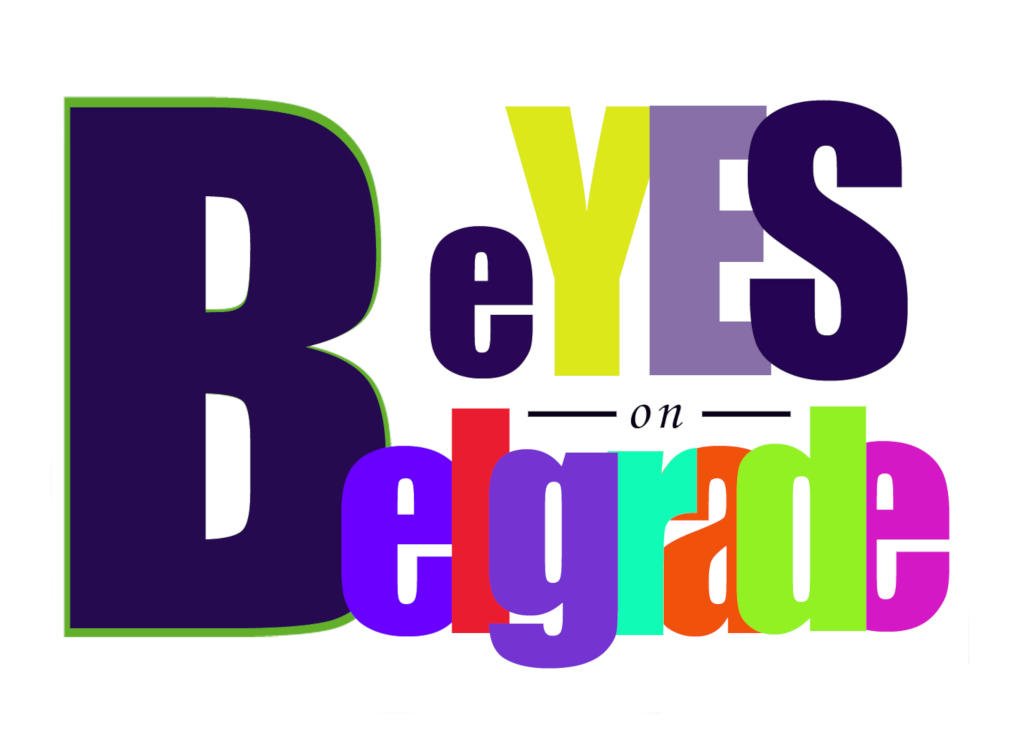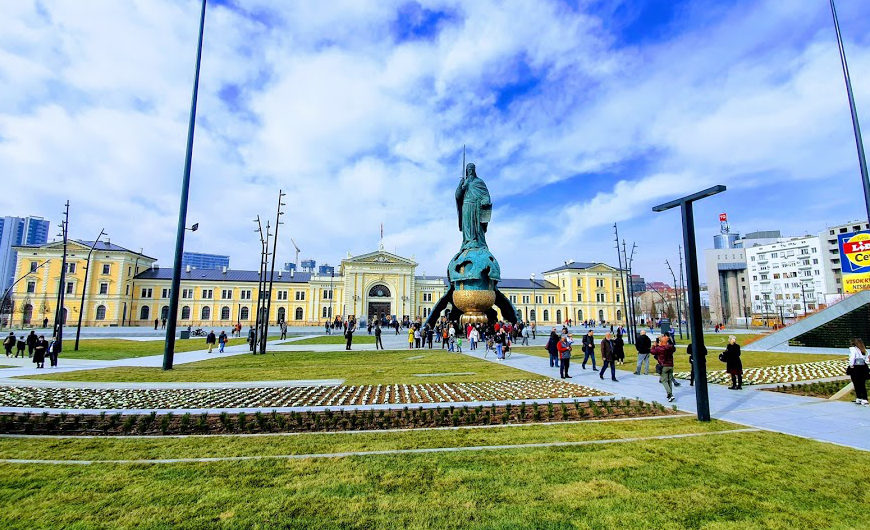For a long time, Savski square was a meeting point of weary passengers from the interior and busy locals. This place also witnessed, in 1892, the genius Serbian inventor, Nikola Tesla, getting off the train from Budapest to be decorated with the Order of Saint Sava and to give a lecture at the University of Belgrade.
The Main Railway Station was built in 1884 in the spirit of Academism and represents a true architectural gem. This exceptional building had a grand opening on August 20 of the same year, when the area was called "Žitni trg" (eng. "Wheat Square"), because of the sacks of wheat that arrived from the nearby docks and were repackaged there. After the end of the Great War (World War I), this part of the city was renamed to Wilson's Square, in honor of US President Woodrow Wilson, who proved to be a great friend of Serbia and showed enormous respect to the Serbian people for their efforts and suffering during the war establishing the Serbian Day in America, on July 28, 1918, on the occasion of the fourth anniversary of the Austro-Hungarian declaration of war on our country. On that day, the Serbian flag was flown at the White House in Washington, paying tribute to Serbian war heroes, but also as an expression of friendship to the future generations. The only two flags of foreign countries that ever fluttered on the White House were Serbian, in 1918, and French, whose banner was exhibited in 1920, on the occasion of the celebration of the Day of the Fall of the Bastille.
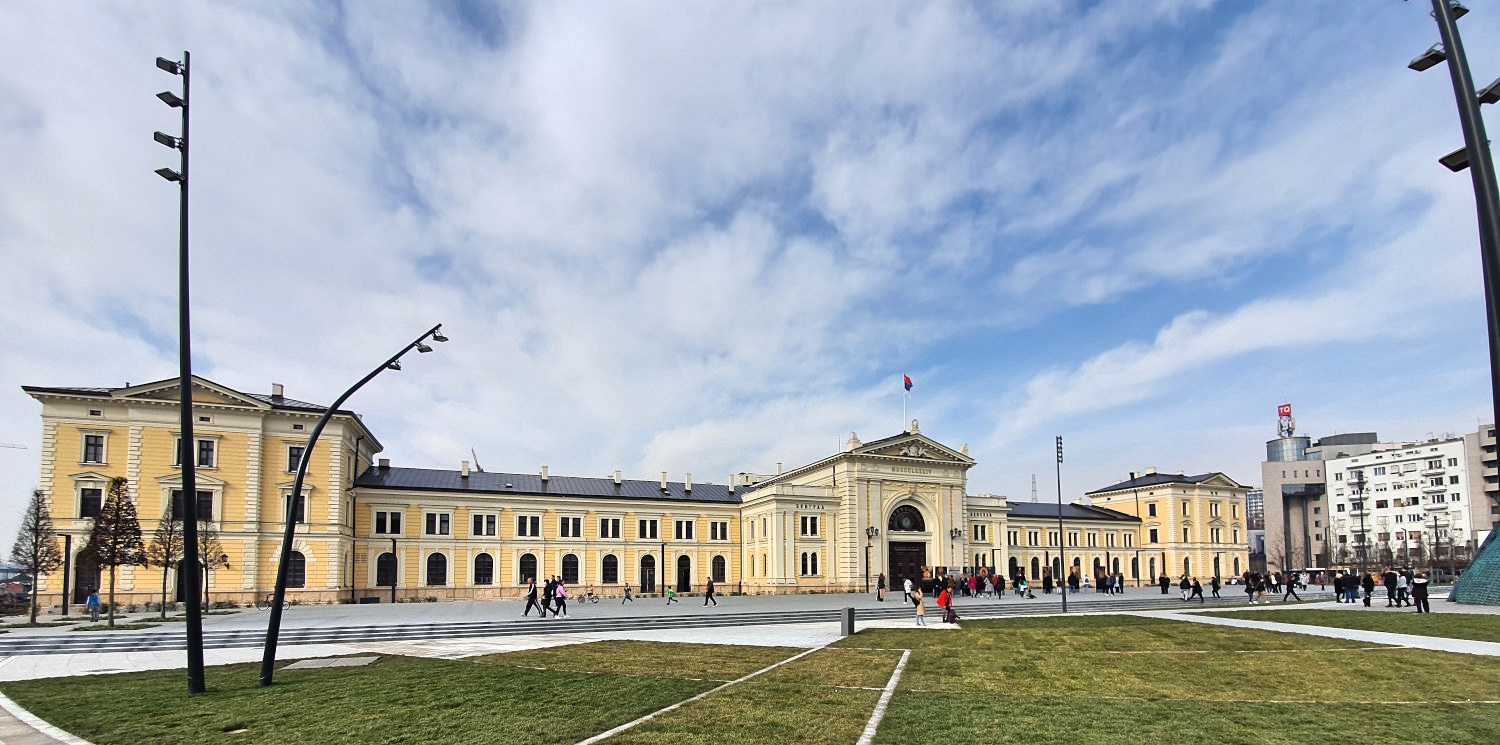
Building of the old Main Railway Station
With the construction of the railway, in the second half of the 19th century, the conditions were created for Belgrade to expand and develop into a real European capital. As early as 1885, the capital of Serbia became a regular stop on the route of the famous Orient Express, a luxury train that connected Western and Eastern Europe, Paris and Istanbul, for the next almost a hundred years, until the line ceased to operate, on May 19, 1977.
Belgrade, known for its cosmopolitan spirit, had this place as the starting point of its cultural and economic expansion for a long period of time.
After the Second World War, the public area around the Main Railway Station was named Savski Square, due to the river Sava, which flows in the immediate vicinity.
In the 1980s, this place became a symbol of everything that is immoral and socially unacceptable or deviant. There was the cinema "Partizan", where pornographic films were shown, while prostitutes could be seen walking and offering their services even in broad daylight. There were all kinds of suspicious characters who sold or enjoyed drugs in the neighborhood, pickpockets, bullies, as well as others who showed various forms of socially deviant behavior. Or the homeless ones, those unfortunate, who wandered there without any hope.

Old Main Railway Station and Savski square before reconstruction
The building of the Main Railway Station, especially in the 1990s, lost the last trace of its former splendor and became a completely inconspicuous place, a symbol of a faltering country and general poverty.
At the beginning of 2021, the history of this place turned the page and got its new chapter.
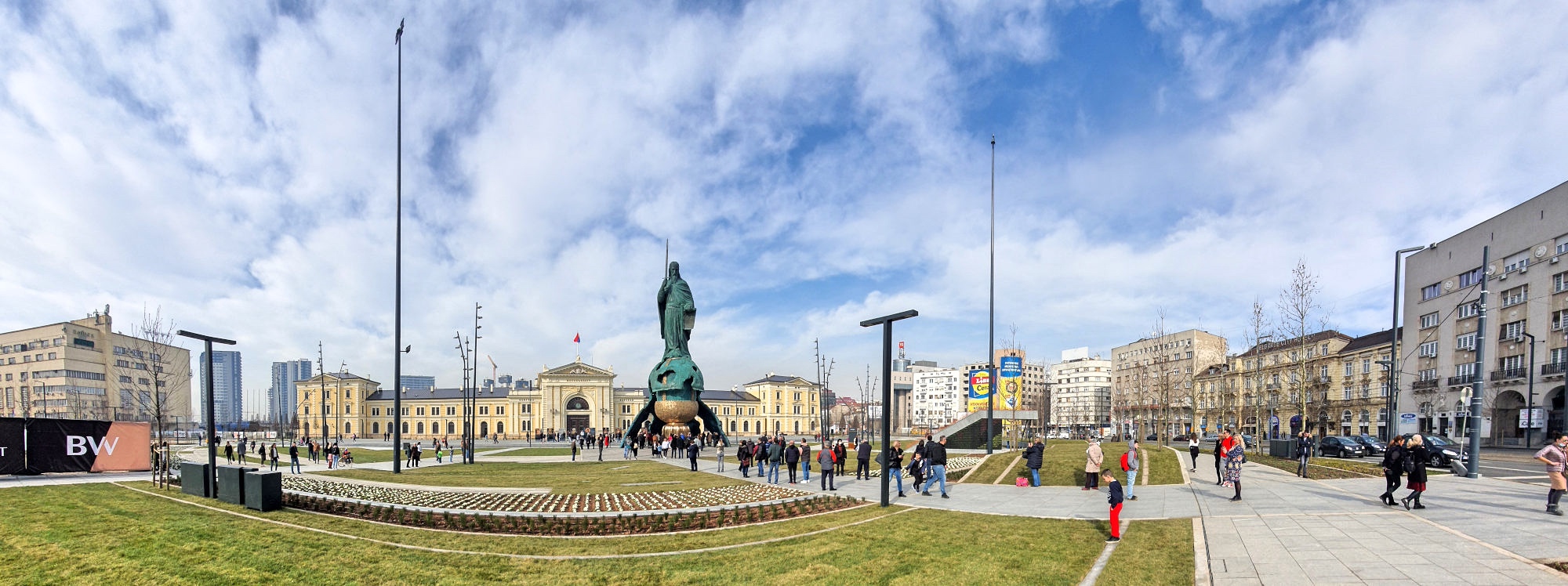
Panoramic view on Savski square and monument to Stefan Nemanja, with the Main Railway Station building in the back
The reconstructed Savski square with the grand monument to Stefan Nemanja caused a lot of reactions and controversy. Prior to the extensive works carried out on the complete redevelopment of this semicircular space (or semi-elliptical, more precisely), Savski square was a large and busy crossroad, which in its widest part had four lanes in one direction and three in the other, and pedestrian islands with tram stops in between. It had a separate wide access entrance to the Main Railway Station, for passengers and taxis, as well as an arched branch, on one side of the perimeter, in three lanes, which served as a public transport ending point. Only one small triangular plateau was paved, which was really a kind of an improvised resting place for pedestrians, with several stone benches, rather than a planned functional space.
After the reconstruction, the square became mostly a pedestrian plateau, while the traffic takes place only along the arched rim in four lanes, two in each direction, which are separated in the middle by tram rails.
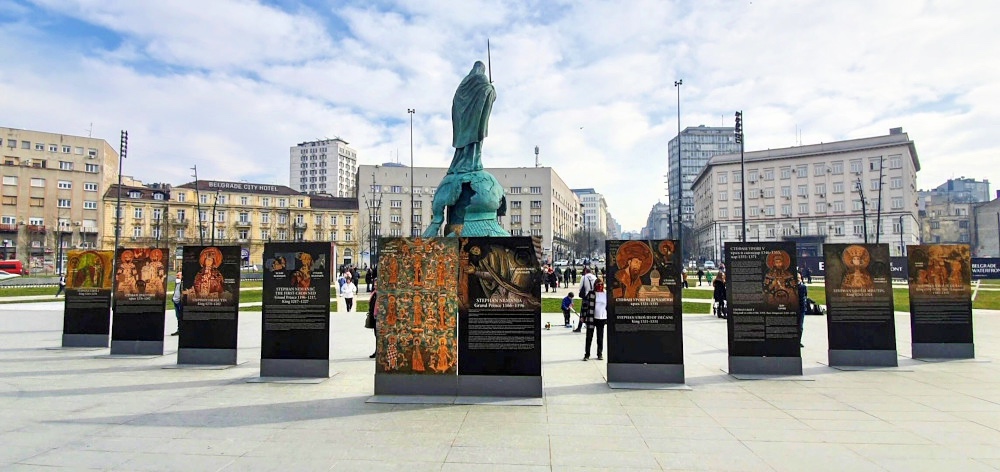
A view from the back to Stefan Nemanja monument with the explanatory panels for the members of Nemanjić dynasty
From the busy road, where pedestrians moved only on the sidewalk, intending to catch transport to their destination, whether by public bus and tram, or train, this space is now converted into a pedestrian zone, where people come to take a walk and be inspired by cultural and historical contents.
An absolutely necessary condition for carrying out this endeavor was the relocation of the Main Railway Station, whose premises will be given a new purpose in the next few years. Namely, this building, which is a cultural monument of great value, will become the seat of the Historical Museum of Serbia, in perfect concordance with the monument to the founder of the medieval Serbian state, Stefan Nemanja (ruled from 1166 to 1196).
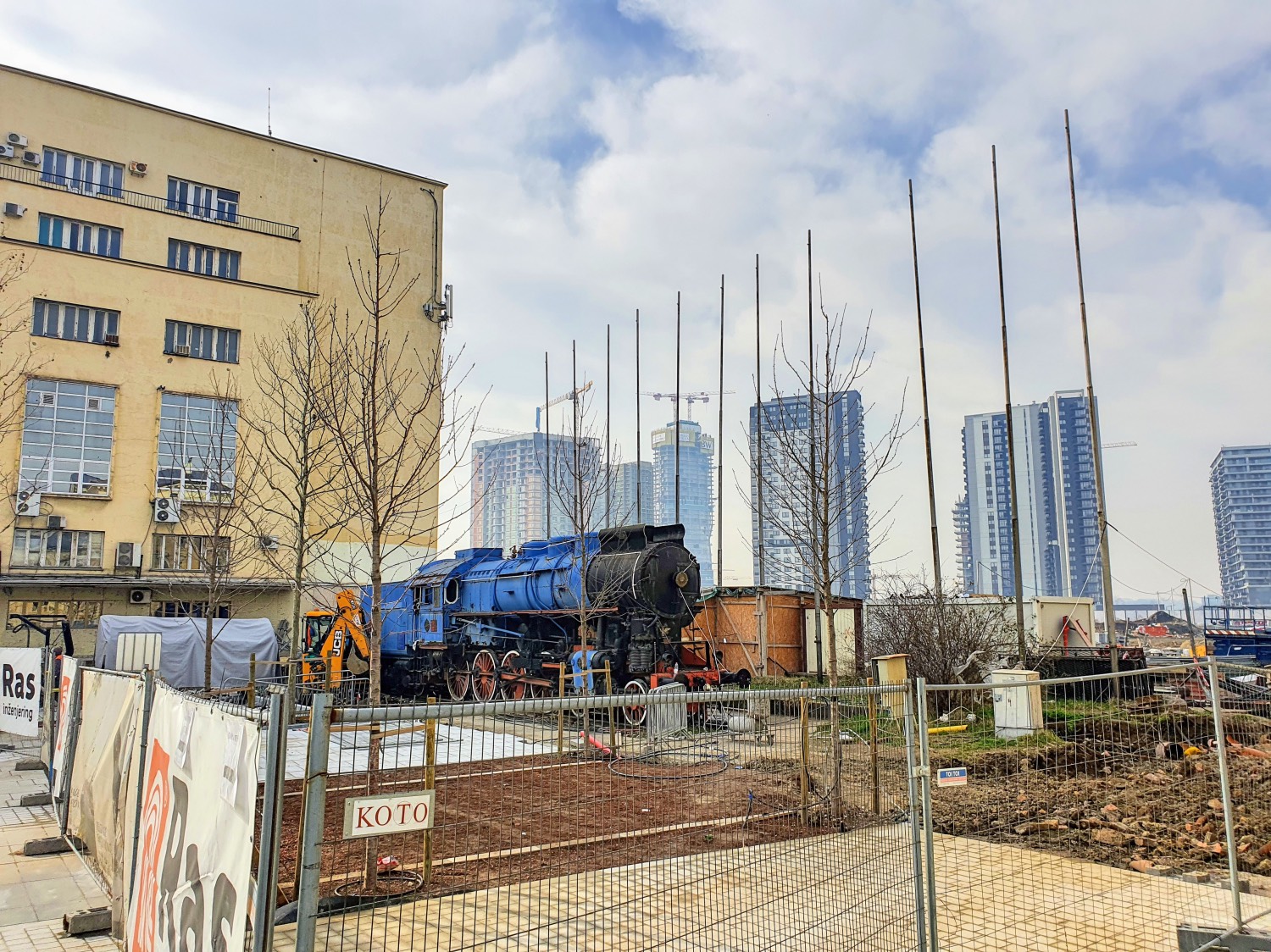
The "Blue locomotive"
The memory of this place from back in the day is preserved through the "Blue Locomotive", placed between the buildings of the Main Railway Station and the Post Office, back in 1984, honoring the centenary of the construction of the first line of Serbia's railway, that connected Cities of Belgrade and Niš (the same time when the Main Railway Station building was opened), but also in celebration of the Day of the Railway Workers, and the thirtieth anniversary of the so-called Yugoslav railway workers' self-management (based on the Yugoslav socialist model, which basically presumed the transfer of company's management to the hands of the workers and employees). There are some voices that say that this monument will remain in its place, but it is necessary for the locomotive to be restored, since it is in a very bad condition. From 1947 to 1957, this locomotive hauled Tito's luxury "Blue Train", which Yugoslav Marshal used for his trips all over the country, and in which he hosted many world statesmen, including the English Queen Elizabeth II.
However, there is still a problem of potential traffic jams caused by significant narrowing of the roadway, given that this point connects very important lines between the old part of the city and New Belgrade. However, in the next period, it should be solved by repairing other crossroads, with the announced relocation of the old tram bridge and the construction of a new one, and, consequently, the redirection of the traffic.
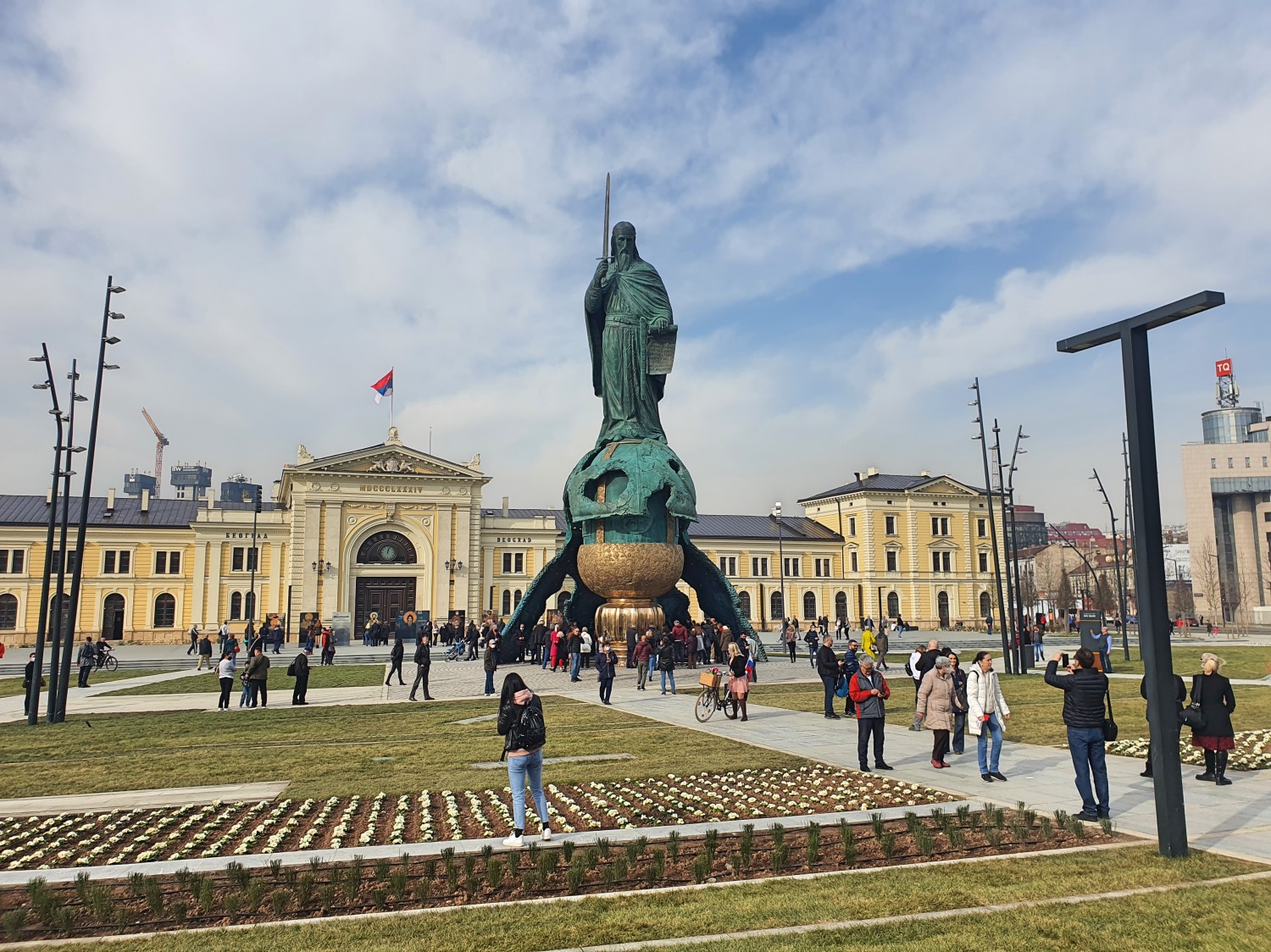
Central part of Savski square with the monument to Stefan Nemanja
The pedestrian zone now covers over 12,000 square meters, compared to hardly 2,000 square meters that small plateau previously occupied. Also, current walking area is twice as large as the plateau on Republic Square, which is considered the main city square. In this way, a symbolic triangle was obtained, with three large and beautiful public spaces, bordering the narrow center of the city, on the stretch Republic Square - Vračar Plateau (with the Church of St. Sava) - Savski Square. These three locations are about 1.5 to 2 kilometers apart, easy reachable on foot.
The monument to Stefan Nemanja now occupies the central part of Savski Square, and with a height of 23.5 meters, it certainly represents the most impressive part of this surroundings. Its monumentality was certainly one of the controversial points, both in the circles of the profession and among the general public. Namely, the argument against the construction of a grandiose memorial to one of the most important figures in Serbian history was precisely that its size, some argue, does not correspond to the urban city core. In addition, it is stated, it pushes to the background the building of the old Main Railway Station, which is an architectural work of exceptional value and a cultural monument itself, and which can no longer be fully appreciated. The monument rises a few meters above this building, but it is placed approximately fifty meters away from its main entrance, so maybe it does not visually represent a significant obstruction.
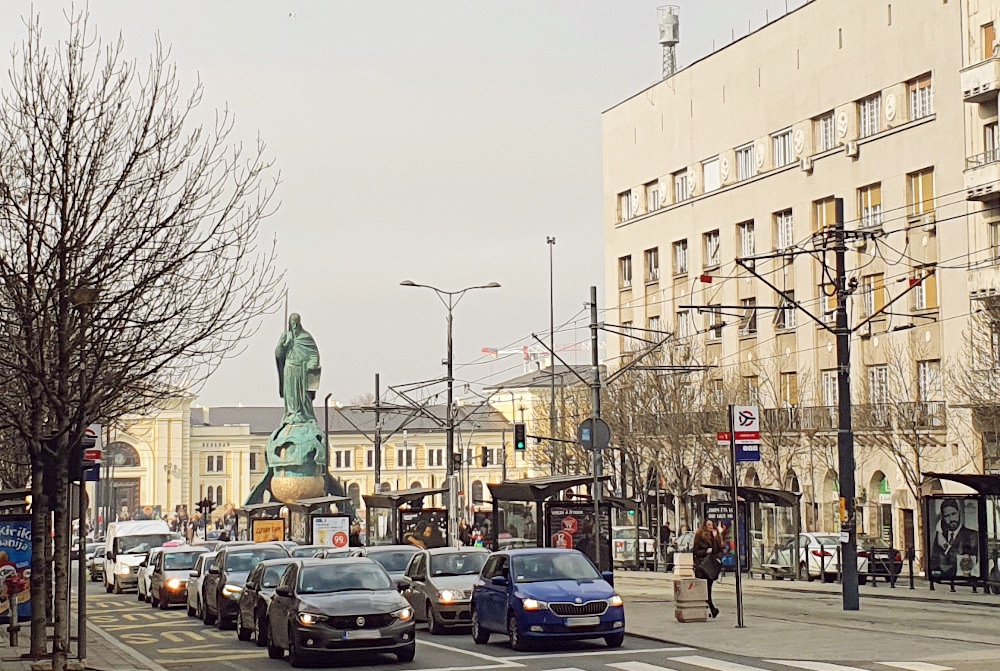
A view on Savski square from Nemanjina street
Let's take a moment and consider the monument to Maria Theresa, in Vienna, nearly 20 meters high, which is also located in the very center of the city, between two almost identical buildings, Kunsthistorisches museum (eng. the Museum of Art History) and Naturhistorisches museum (eng. the Museum of Natural History). The difference is, however, that in the central part of these buildings, the domes significantly (almost twice) exceed the height of the monument, and even the wings are a few meters higher, so the general impression is that these edifices absorb the grandeur of the monument, and not the other way around.
Another interesting detail which can contribute to different impressions when observing the monument in the context of its surroundings is the size of the pedestal, which in the case of the monument to Stefan Nemanja is just over half the total height, while in the case of Maria Theresa makes up almost three-quarters of the monument. The ratio of the height of the figure and the pedestal can also play a significant role in creating a complete impression.
Not wanting to take sides, we will, in the end, leave it up to you.
The monument to Stefan Nemanja abounds in symbolism, which is also the subject of numerous debates and controversies. He stands on a broken Byzantine helmet, which symbolizes that the independence of the Serbian medieval state was won in the fight with the Eastern Roman Empire.
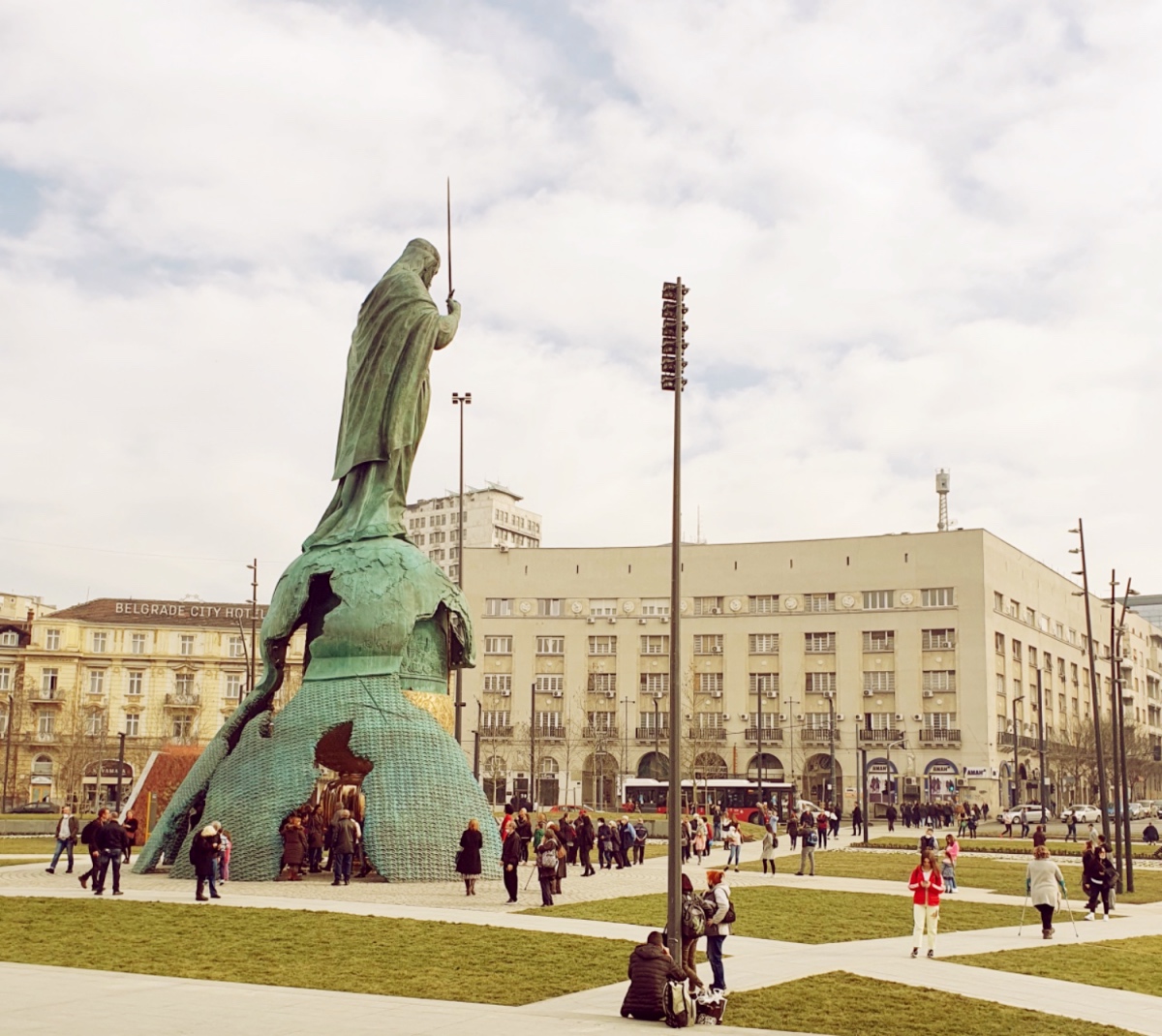
We believe that this symbolism cannot be interpreted in the way, as some say, that the Serbian state was created on the Byzantine ruins, since Byzantium existed for several centuries more as a powerful state. Also, one of the understandings is that "Serbian culture was born from Byzantine culture", as the author of the monument, Russian academic sculptor Alexander Rukavishnikov, stated. This explanation can also be considered questionable, but on this occasion we do not want to go too far into historical estimates. Certain parallels can be observed in relation to the ancient Greek myth of the birth of the goddess Athena from the cracked head of Zeus.
As the pedestal is multi-layered, the helmet forms only its upper part (although it has four legs stretching to the ground). Under the helmet is the main part of the pedestal, which is made in the shape of a gilded episcopal scepter of his son, Saint Sava, which is driven five meters into the ground, and it can be seen through the transparent glass at the foot of the monument. Above the ground, there is the head of the scepter that looks like an acorn, so at first, often wrongly, and often maliciously, it was stated that Stefan Nemanja was standing on an acorn.
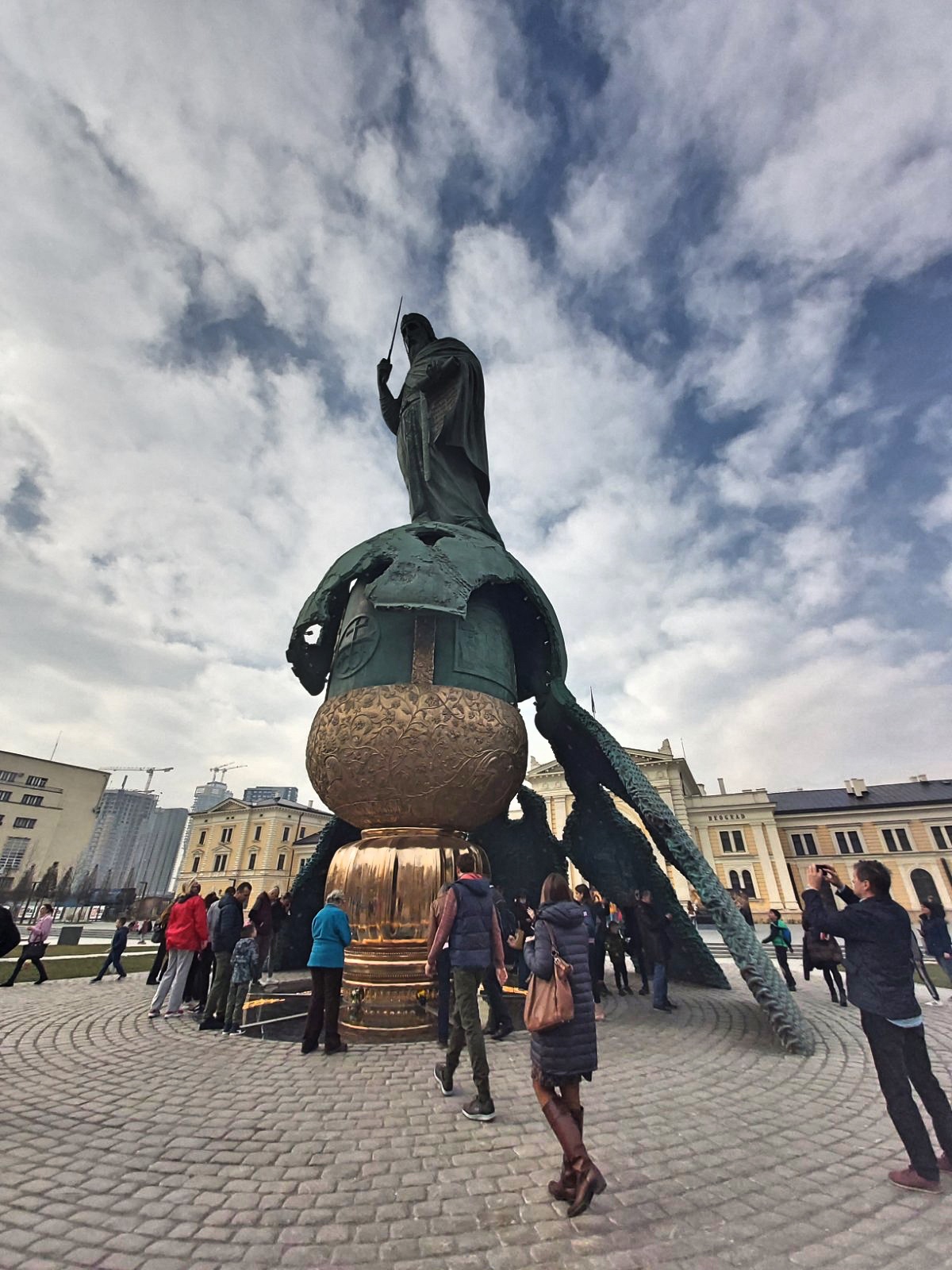
Monument to Stefan Nemanja and the pedestal in the shape of the episcopal scepter, covered with the broken Byzantine helmet
Stefan Nemanja, as a grand prince of Serbia, is standing on his son's episcopal scepter. Nemanja's youngest son, Rastko Nemanjić, was the first archbishop of the Serbian Orthodox Church (from 1219), and the spiritual leader of Serbs, remembered by his church name, Saint Sava. In the 17th century, significant changes were made to preserve the scepter, which caused it to lose its authentic appearance, so what we see today on the monument is actually the modified version. However, this is, it is stated, the only personal item that remained from Saint Sava and it is kept in the treasury of the Mileševa monastery. One of the open questions is whether Nemanja should be standing on his son's episcopal scepter.
The head of the scepter, which is covered by a broken helmet, is a "mountain crystal" or quartz. This semi-precious stone adorns the original scepter. On that part of the monument, on the front side, there is a large "Studenica Cross", special in a sense that it is split in the lower part, which symbolizes on the one hand the early Christian iconography of the anchor, and on the other the growth and progress, reflected in floral endings.
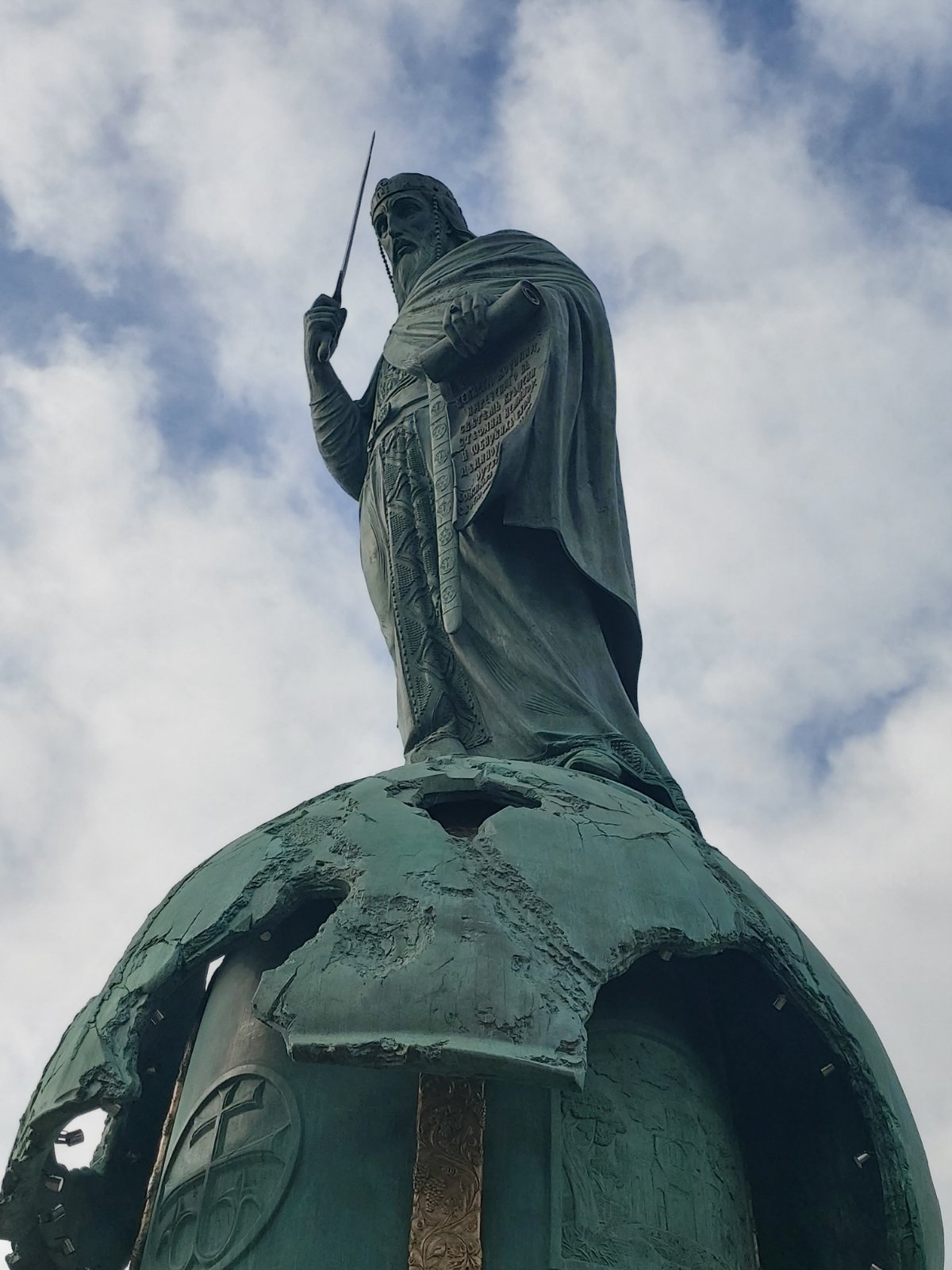
"Studenica cross" (on the left)
The original cross is located above the northern portal of the Virgin's Church in Studenica, the endowment of Stefan Nemanja from 1196. Next to it, on the pedestal, on one side we have a representation of the Virgin's Church, and on the other the Hilandar monastery.
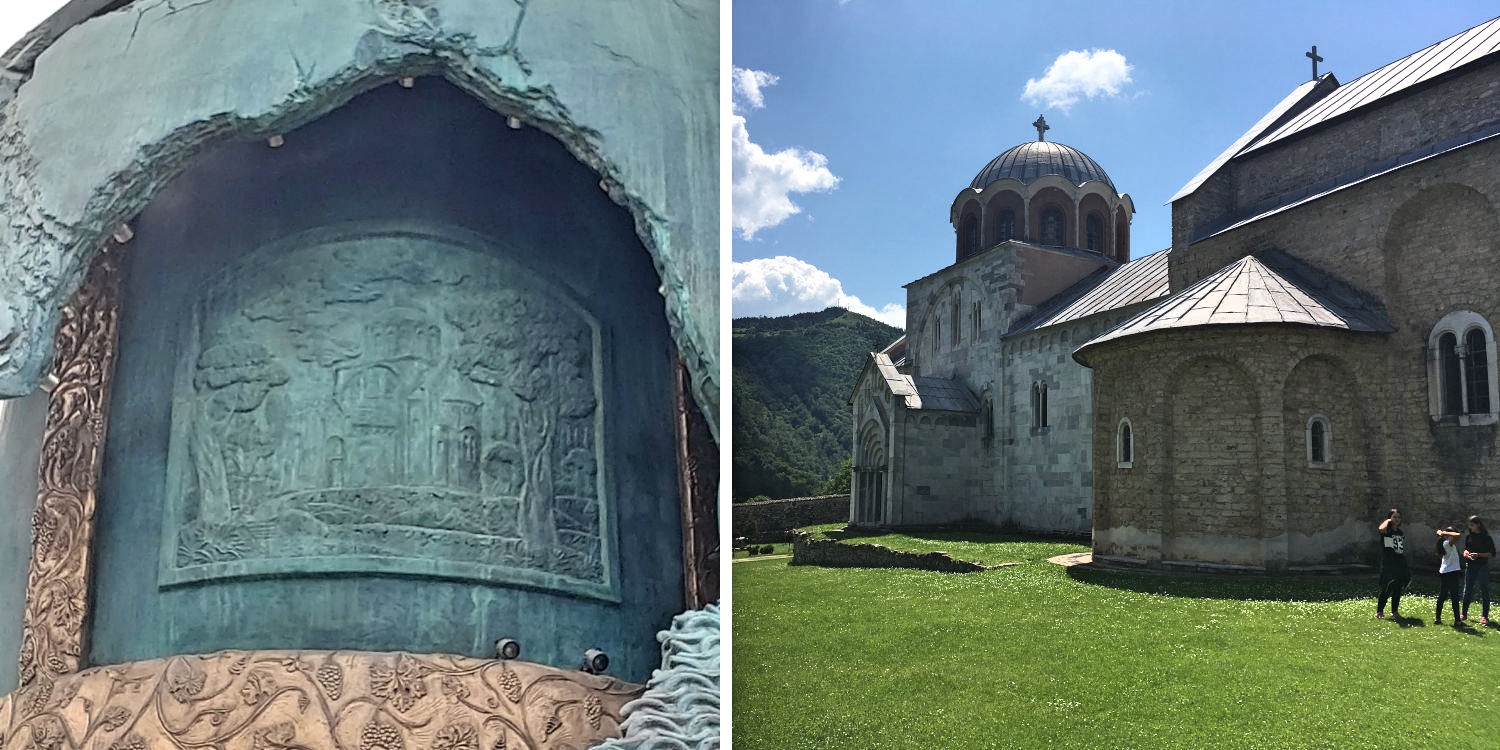
Representation of Studenice monestary on the pedestal of the monument and the actual monastery
The gilded holder of the head of the episcopal scepter, at the foot of the pedestal, is interspersed with a representation of a vine, which is said to be a symbol of the noble Nemanjić dynasty, but also points to the legend that this plant grew from the tomb of Stefan Nemanja after he was originally buried in Hilandar monastery.
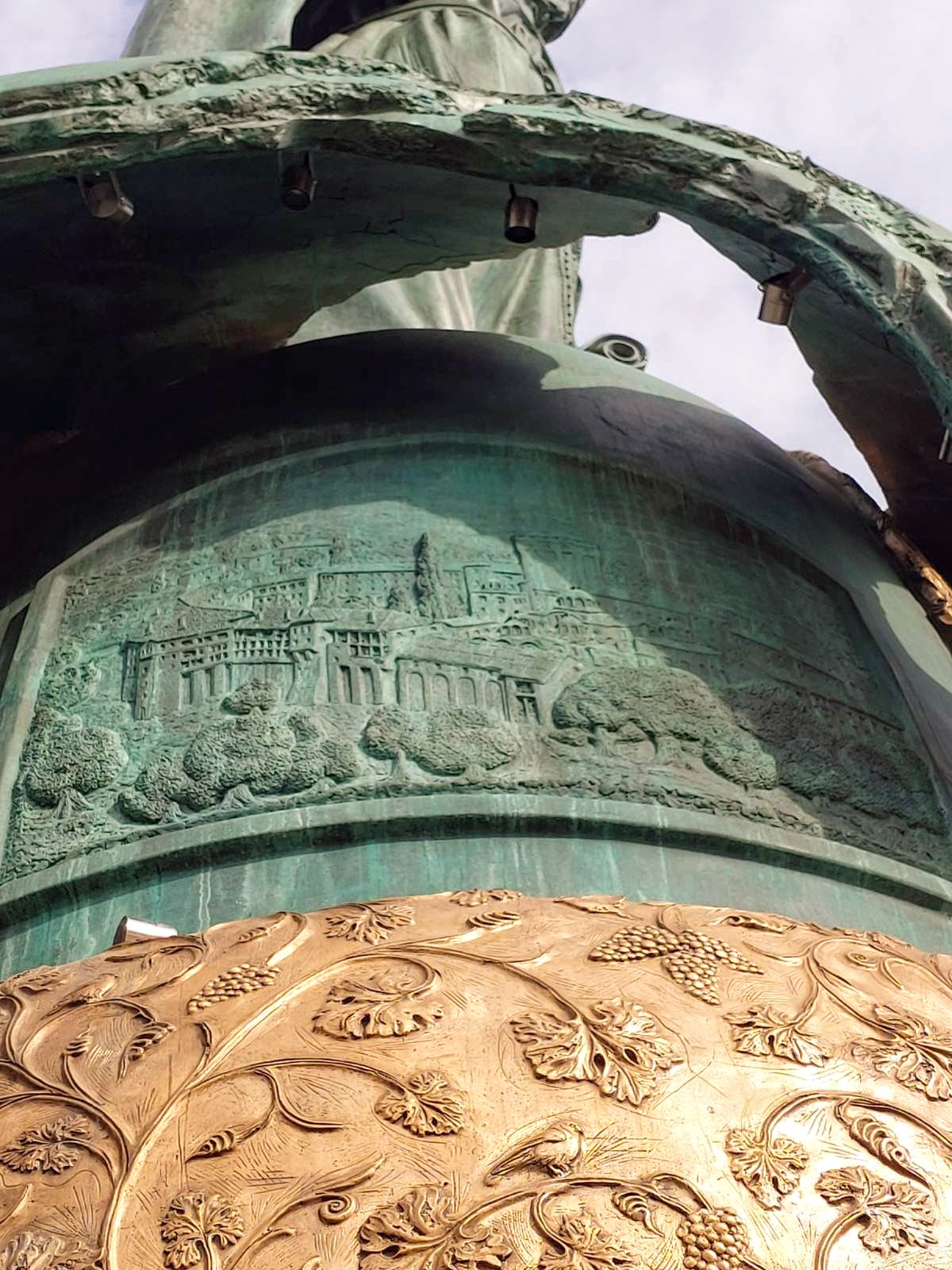
Representation of Hilandar monastery
On the front, there is a large inscription in two lines "Great Serbian Prince Stefan Nemanja", and above it the coat of arms of Nemanjić dynasty is placed.
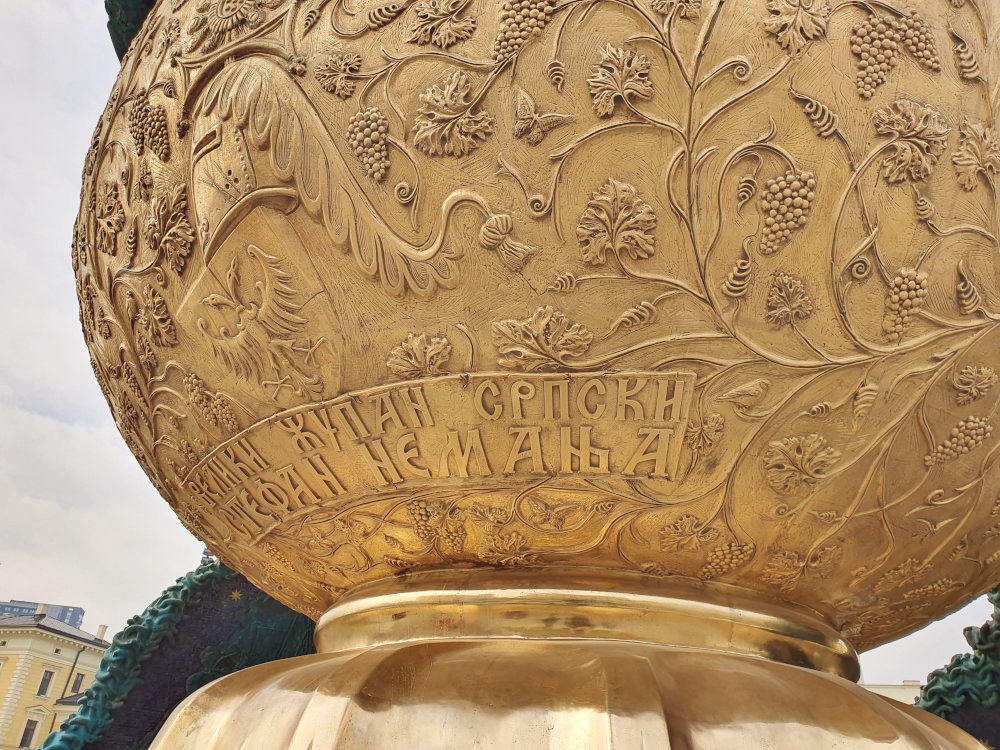
Also, on this part of the pedestal we find representations of a mythological creature, Sirin (half woman, half bird), which adorns the lintel of the western, main portal in Studenica, and the "Studenica eagle", which is located at the same place, above the entrance to the Virgin's Church and which represents, as it is stated, "Stefan Nemanja, the Serbian people and the state, which is breaking out of all the turmoil of this world in order to develop and soar towards the eternal port - the kingdom of Christ".
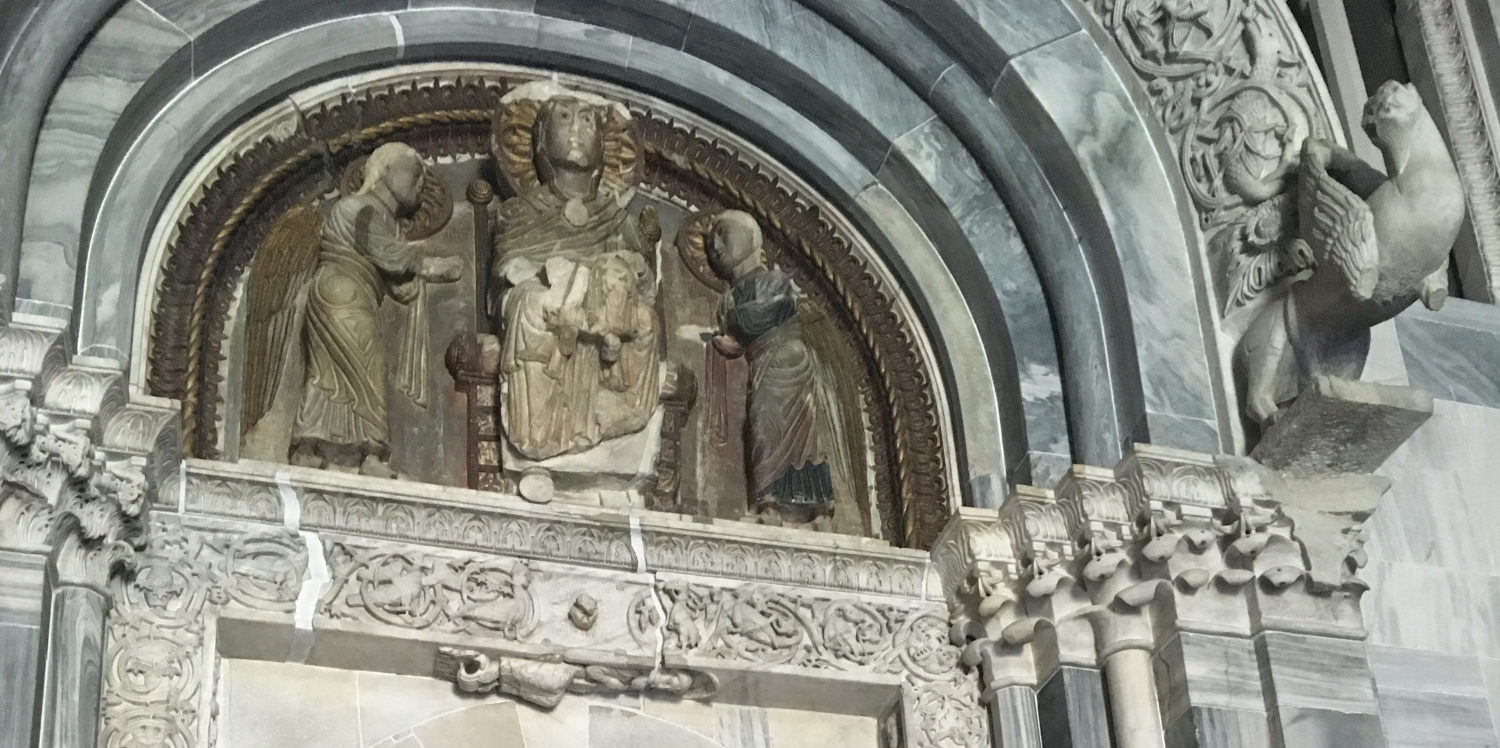
Lintel of the main portal of the Virgin's Church in Studenica monastery
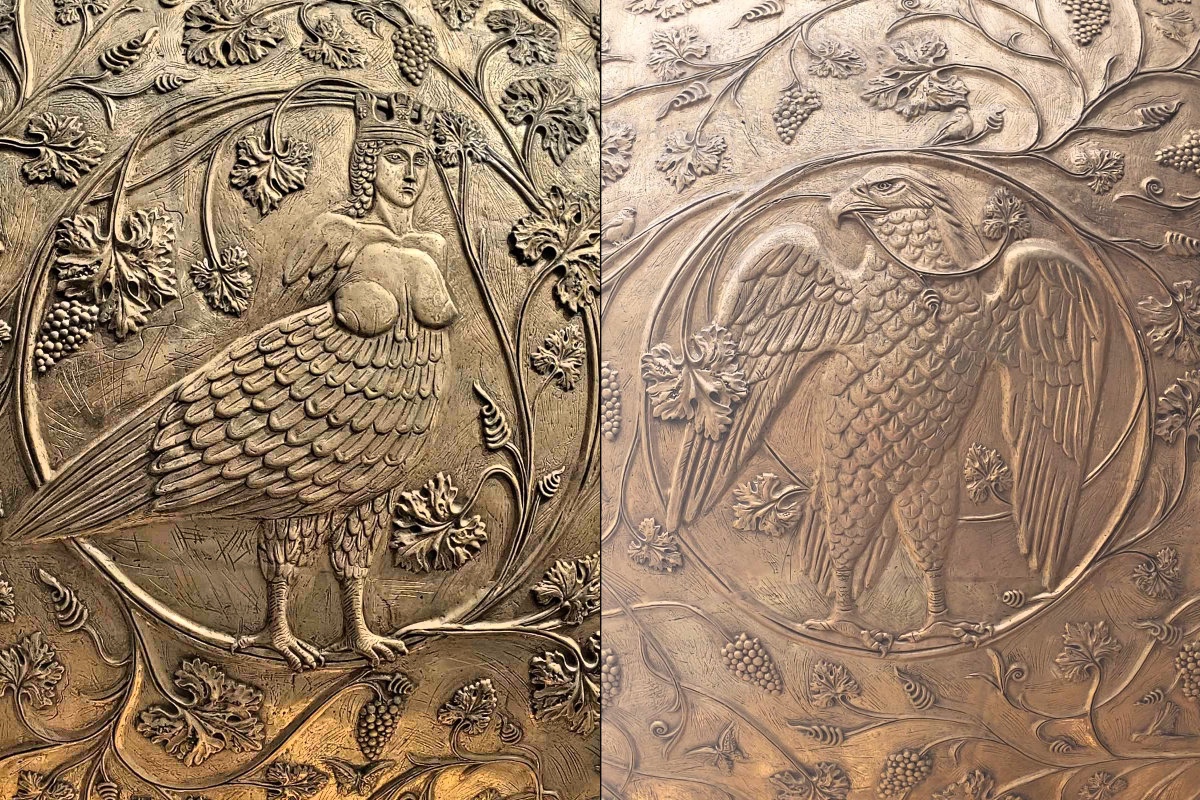
Sirin and "Studenica eagle"
On the inside of the arms of the helmet are four displays, which, we believe, are symbolically painted on a Byzantine-blue background (lat. Lapis lasuli) with yellow stars, which is associated with one of the most beautiful Serbian frescoes, colloquially called "Studenica crucifixion", in the original "Crucifixion of Jesus Christ", which was painted in a color that was so rare and so difficult to find, that it was more expensive than gold itself. They say that for only a liter of this color, which was obtained from crushed semi-precious stone found in Afghanistan, more than a kilogram of gold should have been given in return. This color, in addition to its beauty, is extremely durable and was very much used in painting our monasteries.
There is an interesting story (we do not know if it is true, but we would certainly like it to be), which says that the great Italian painter, Giotto, saw this color for the first time in our monasteries, as well as beautiful frescos on their walls, so he painted the famous Chapel of the Scrovegni in Padua inspired by it.
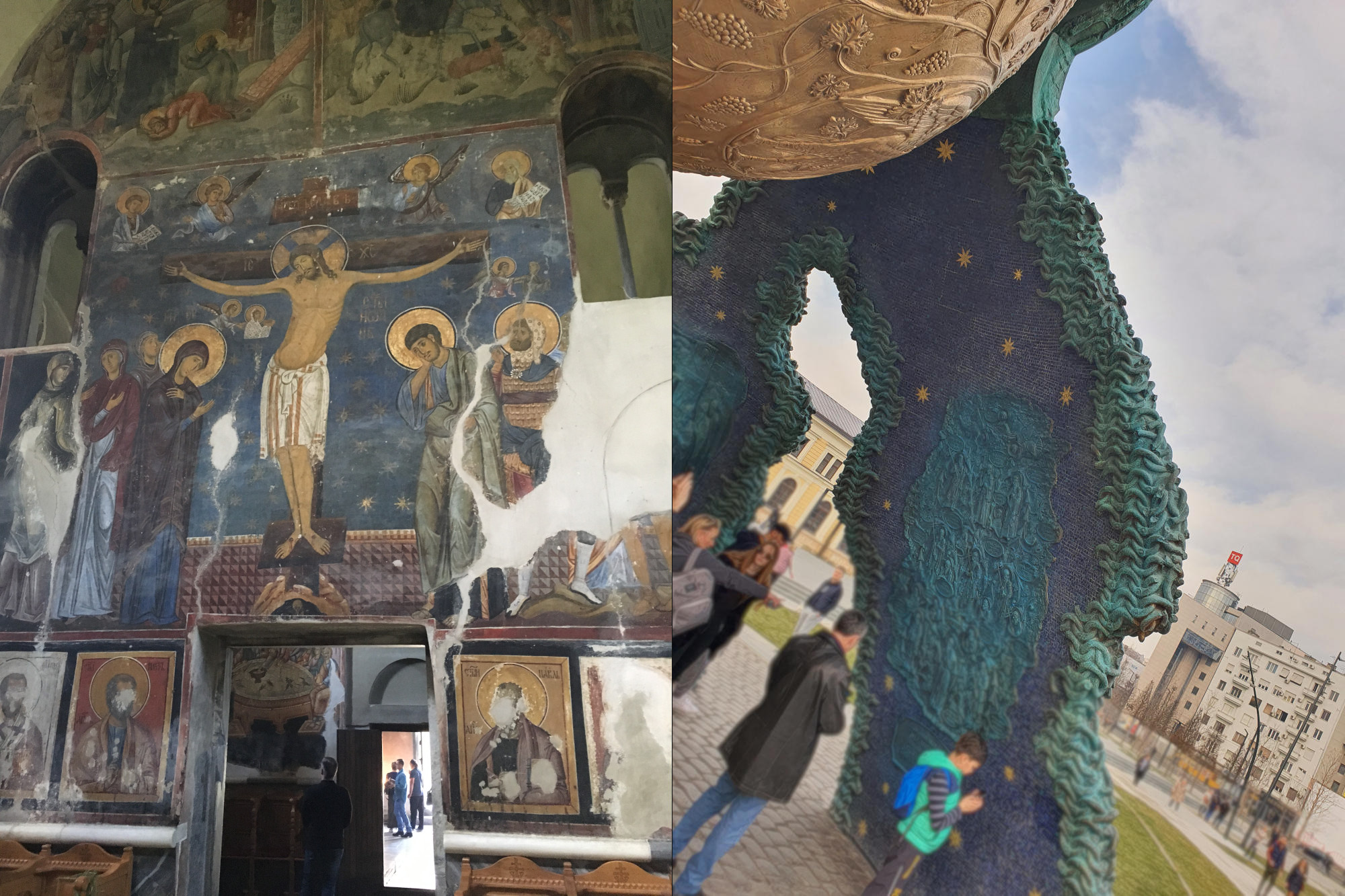
"Studenca crucifixion" and Byzantine-blue color with yellow stars as a substrate for depictions of Nemanja's life
If we enter, therefore, at the foot of the helmet, we will see the following depictions (picture below): The creation of the Serbian state, symbolically through the battles fought by Nemanja (bottom right); Parliament in Ras in 1196, when Nemanja handed over power to his middle son, Stefan, who will remain in history known as the first Serbian king, Stefan the First-Crowned (top left); Lineage of Nemanjić dynasty, who ruled Serbia for almost 200 years, until the death of the last sovereign - Emperor Uroš the Weak in 1371, through a genealogical tree for which a template was taken from the monastery of Visoki Dečani (bottom left); Transfer of the relics of Stefan Nemanja from Hilandar to Studenica (top right).
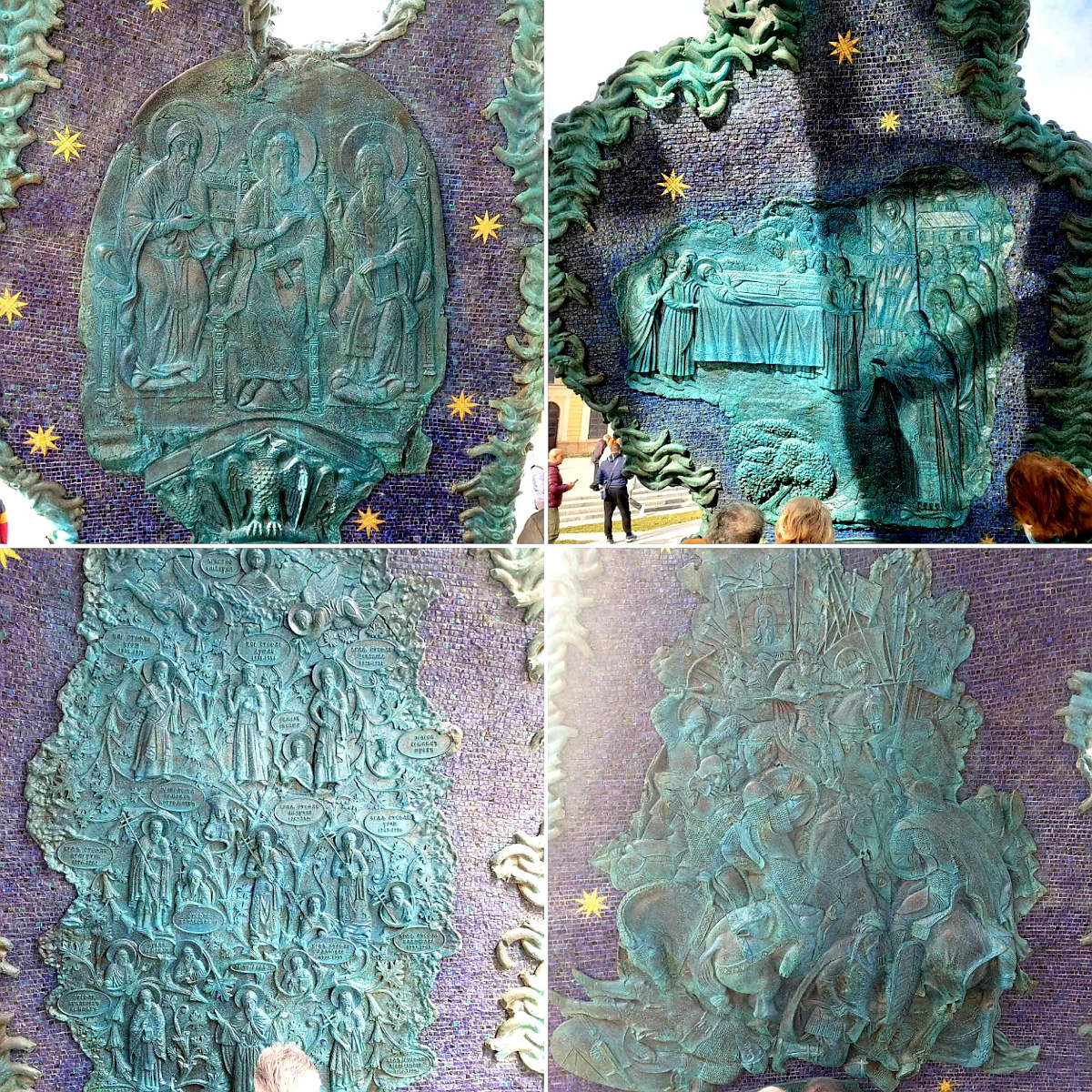
Finally, the appearance of Stefan Nemanja's figure could not pass without very loud objections as well. There are several problems with it, as it is argued by certain professional circles, as well as a part of the public. First of all, why Nemanja carries a sword in his hand? Truth be told, in the original proposal for the solution of the monument, Nemanja held a cross. Some claim that the change came about because of the Russian cross that was originally implemented, but that was very easy to solve, by simply remaking the appearance of the cross. Apparently, it is something else. Authorities say it was decided to ask the artist to place a sword instead of the cross to emphasize Nemanja's secular role, as the monument's emphasis is on his state role, not the later figure of a monk and saint.
After all, Nemanja became a monk only three years before his death. However, all the ideas we have about him are from the frescoes of the monasteries, in which he is presented in a monastic uniform. Hence the representation of his figure. Therefore, in addition to the fact that the sword stands unnaturally in his hand, because the pose is designed for the cross, many consider completely inappropriate to portray him as a ruler in a monastic uniform. However, the question is to what extent Nemanja's clothes on the monument are exclusively monastic.
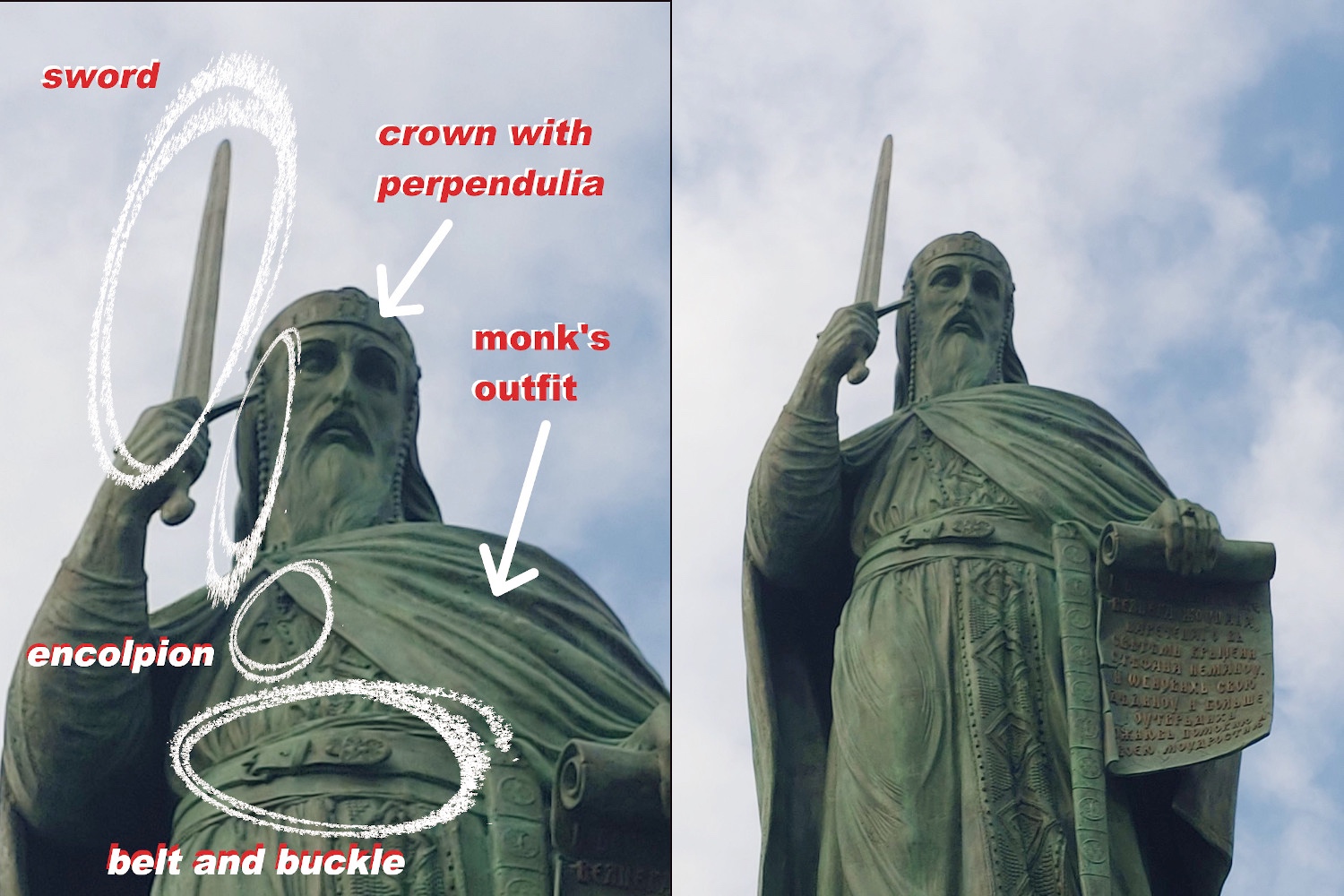
Controversy around the monument
One of the objections was the ruler's crown with perpendula (pearl chain) on the side, considering that it is questionable whether Nemanja, as a great prince, wore any crown on his head at all. The explanation we have received is that such a crown is something that rulers of that rank could or did wear at that time.
Stefan Nemanja's character is inseparable from his church life. After becoming a monk, he was given the name Simeon, and upon his death he was canonized as Saint Simeon the Myrrh-bearer. On our monument, he wears a cross on his chest - a variant of the encolpion, worn only by church dignitaries, which is another in a series of objections regarding the mixing of symbolism and, in general, unclear orientation or essence of the monument. However, given that this is a period that is very poorly documented, and having the sources that almost exclusively represent Nemanja in his monastic role, as well as the dual nature of his influence, on the one hand on the development of Serbian statehood and on the other on the development of Serbian culture, then the question rightly arises as to whether it was at all possible to determine and present Stefan Nemanja in any other way.
Nemanja carries a raised sword in his right hand, while in his left he holds a scroll from the Hilandar Charter. It is, in fact, the founding charter of the Hilandar monastery, which Nemanja founded on the Holy Mountain of Athos together with his son, Saint Sava, and which has remained the only Serbian monastery among the twenty Orthodox monasteries located in that place. This writing, in the Old Church Slavonic language, is still kept in Hilandar and represents, in fact, Nemanja's biography. On the passage that Nemanja holds in his hand, it is written: “And God appointed me as a great prince, called in the holy baptism by the name of Stefan Nemanja. And I renewed my ancestry and strengthened it with God's help and my wisdom. " On the finger of the hand with which he holds the charter, the ruler's ring is visible.
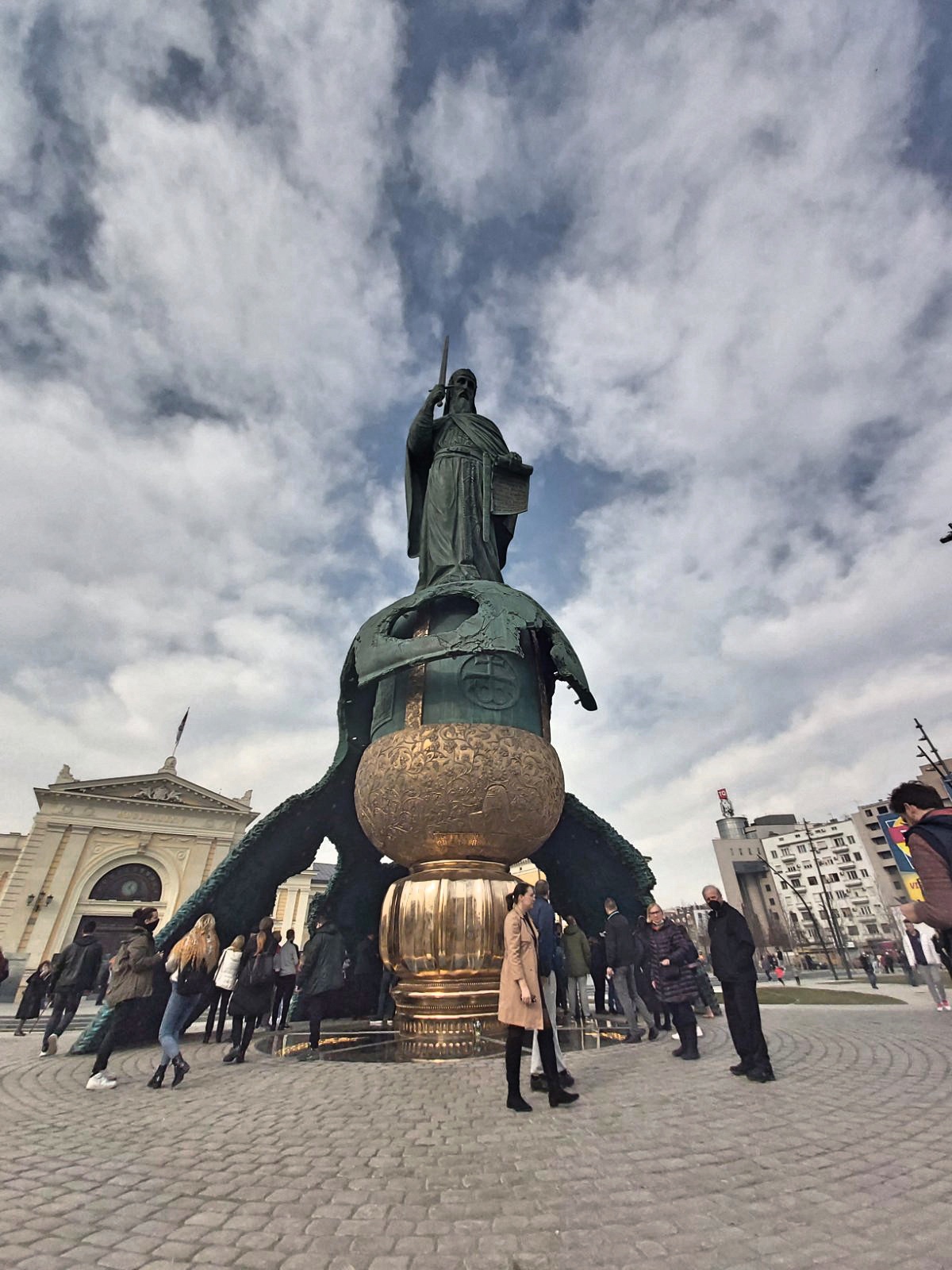
In the end, voices were heard commenting on the depiction of his belt and buckle, but a simple search on the Internet shows that the look shown on the statue of Stefan Nemanja is something that was completely appropriate for the Middle Ages.
This truly grandiose monument, which weighs between 70 and 80 tons, undoubtedly attracts the attention of the public and will certainly be a significant tourist attraction.
Nemanja looks upon the street that was named after him in 1896. Nemanjina street is exactly one kilometer long and ends at Slavija Square, from where the magnificent Church of St. Sava rises some 400 meters uphill, erected in honor of his son, Rastko, who is remembered in the Serbian tradition as the spiritual father of the Serbian people, Saint Sava. So, we find symbolism here as well, since Nemanja is actually looking at the Church of Saint Sava, whose dome he may well be able to see from a height of 23.5 meters. From the point of view of an ordinary bystander, that is still impossible due to the buildings that block the view.
Romantically, we will imagine that this unification of father and son in the Serbian capital is a sign of the rebirth of a strong Serbian state, both politically and spiritually.
Watch our featured video on this topic:
 English (United Kingdom)
English (United Kingdom)  Srpski latinica (Srbija)
Srpski latinica (Srbija) 